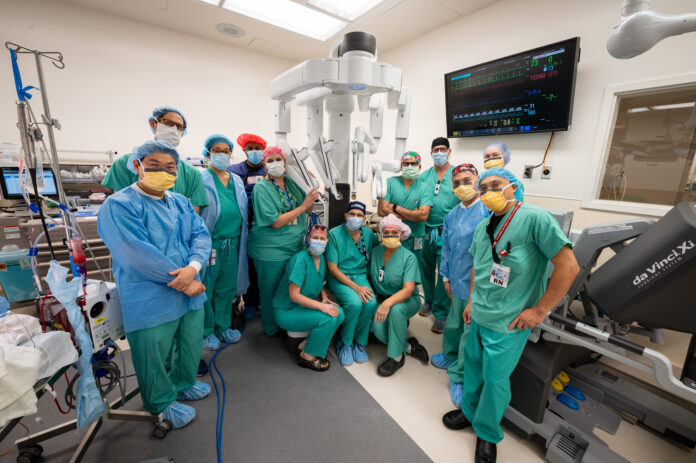Surgeons across North America can undergo training at UC Davis Medical Center for robot-assisted mitral valve heart surgery
By BRANDON NGUYEN –– science@theaggie.org
The American Association for Thoracic Surgery (AATS) Foundation recently delegated UC Davis Medical Center as one of the six national host sites for its Cardiac Surgical Robotics Program. The fellowship program aims to provide “advanced educational experience in robotic cardiac surgery for up to three North American cardiac surgeons with experience repairing mitral valves, who will bring expanded knowledge back to their home institution,” the organization’s website states.
Dr. Bob Kiaii, the chief of cardiothoracic surgery at the UC Davis Medical Center, has been practicing minimally invasive heart surgery with the assistance of a robotic tool for the past 20 years. Kiaii, whose expertise is worth sharing with future surgeons pursuing the collaboration of robotics and cardiothoracic surgery, would be a fitting and honorable surgeon to lead the program.
“We’re extremely fortunate and privileged to be given this opportunity, and it also makes me feel very humble that basically I’m able to be selected as one of such institutions,” Kiaii said. “But all of this was possible because of our amazing teamwork that we have already illustrated, not only to have gone through the training phase ourselves, but how that training that we already experienced is translated to becoming a center where we can show that training to other institutions.”
Unlike conventional surgery, the surgery Kiaii carries out applies advanced technology to minimize the invasiveness of heart surgery while maintaining the same capabilities as a heart surgeon with tools in his hands.
“The robot is a very sophisticated surgical instrument, and the reason why it is sophisticated is because it’s computer assisted robotic surgery,” Kiaii said. “When we do conventional surgery, we make big incisions because our hands are large and we need to have our hands inside the chest cavity to be able to maneuver the hands as we do operations. But with robotic surgery, you get all the same freedom of movement with your hands but through a smaller incision.”
Dr. Jorge Catrip, a surgeon trained under Kiaii for minimally invasive heart surgery at the UC Davis Medical Center, discussed how heart surgery is different from other surgeries and why the advancement of minimally invasive robotic surgery in the field of cardiology is revolutionizing.
“Cardiac surgery is different from other surgical specialties because you have to use the pulmonary bypass pump that circulates the oxygenated blood while stopping the heart so you can surgically operate on it,” Catrip said. “Cardiac surgery is a complex surgical field, and if you then add a robot, it becomes one of the most complex surgeries that requires years of training.”
The growth of technology in imbuing robotics into medical procedures that both Kiaii and Catrip execute is phenomenal for the expansion of possibilities for surgeries. Kiaii provided further insight into how transformative cardiac robotics surgery has been for him in his operations.
“The visibility is amazing because you get a very high definition of fully digitalized three-dimensional views of the chest, or of any cavities that you are looking at,” Kiaii said. “So the precision in doing the surgery gets further enhanced when we do operations. You get 10 times the magnification with the robot compared to regular surgical magnifying glasses in a very highly defined image that allows you to improve your visualization. This allows you to see more detail of the structures you’re looking at to better perform the surgery.”
Allison Ranade and Kimberly Smith, both physician assistants and members of Kiaii’s robotics cardiothoracic team at the UC Davis Medical Center, offered insight into their growth and dedication in their roles to support the main surgeon in the operating room.
“It was a huge stepping stone for all of us,” Ranade said, on behalf of Smith. “He [Kiaii] told us, ‘You’re going to have command of the room. You’re going to tell the nurses what you need.’ And we’ve had so much more autonomy in these cases, because the surgeon is not scrubbed and we truly are the ‘bedside surgeon’ by the patient’s side. I think the learning curve and transition were the hardest, but now I feel most rewarding because we truly are his right hand.”
Cardiac robotics surgery is still in its infancy stages, and Kiaii said he is hopeful that these simulations associated with the Cardiac Robotics Surgery Program that he will be leading at the UC Davis Medical Center can be similarly rewarding for other areas of surgery.
“The future of surgical training is with simulation and with computer-assistance where you can simulate a particular problem a patient has and then using different types of models, you can allow the team to practice to learn how to perform operations,” Kiaii said. “I think that these simulations have already shown to be extremely beneficial for not only trained individual surgeons, but the team that the surgeons work with. These simulations will make the team work better and improve the team dynamic, so I think the future is just at the cusp of the early phases of such training.”
Written by: Brandon Nguyen —science@theaggie.org




